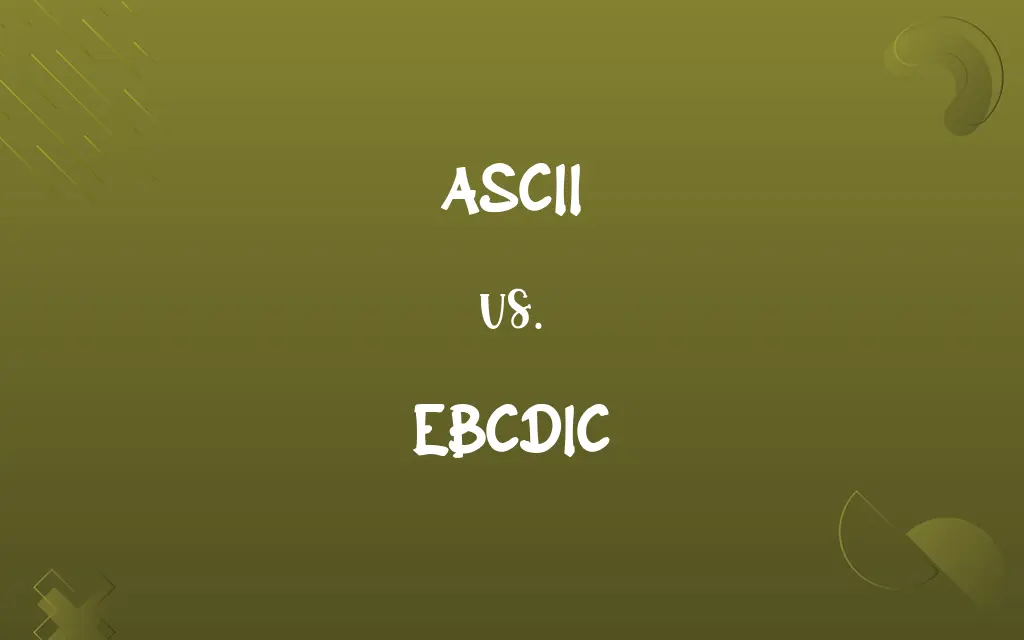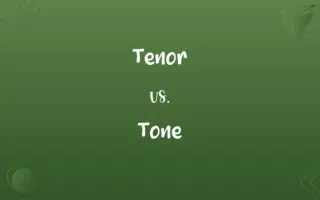ASCII vs. EBCDIC: Know the Difference

By Shumaila Saeed || Published on February 28, 2024
ASCII is a 7-bit character encoding standard for text; EBCDIC is an 8-bit character encoding used mainly in IBM mainframe systems.

Key Differences
ASCII, or American Standard Code for Information Interchange, is a widely used character encoding standard for electronic communication, representing text in computers and other devices. EBCDIC, or Extended Binary Coded Decimal Interchange Code, is a character encoding used primarily by IBM mainframe systems, differing in its structure and design from ASCII.
Shumaila Saeed
Feb 28, 2024
ASCII uses a 7-bit binary code to represent 128 characters, including control characters and printable characters, making it suitable for a wide range of languages and applications. EBCDIC, with its 8-bit binary code, provides 256 character representations, but its design caters more to punch card systems used in early IBM computers.
Shumaila Saeed
Feb 28, 2024
One key difference is the arrangement and values assigned to characters. In ASCII, characters are logically ordered, making it easier to sort data alphabetically. EBCDIC's character arrangement, in contrast, is less intuitive due to its origin in punch card technology, leading to complexities in data sorting and processing.
Shumaila Saeed
Feb 28, 2024
ASCII's influence extends beyond just character encoding; it is foundational in the development of modern coding systems and internet standards. EBCDIC remains more specialized, primarily used in legacy systems within IBM mainframes, with limited use in modern computing environments.
Shumaila Saeed
Feb 28, 2024
Compatibility and interchangeability between ASCII and EBCDIC can be challenging, as converting text between these two requires mapping of character codes, which may not always have direct equivalents. This difference underscores the specific design goals and usage contexts of each encoding system.
Shumaila Saeed
Feb 28, 2024
ADVERTISEMENT
Comparison Chart
ADVERTISEMENT
ASCII and EBCDIC Definitions
ASCII
ASCII represents text in computers, telecommunications equipment, and other devices.
ASCII characters are fundamental in text files.
Shumaila Saeed
Jan 19, 2024
EBCDIC
EBCDIC stands for Extended Binary Coded Decimal Interchange Code.
EBCDIC supports a larger character set than ASCII.
Shumaila Saeed
Jan 19, 2024
ASCII
ASCII uses a set of 128 symbols to represent letters, numbers, and control codes.
ASCII includes control characters like newline.
Shumaila Saeed
Jan 19, 2024
EBCDIC
EBCDIC is a character encoding system used in IBM mainframe computers.
EBCDIC was designed for compatibility with IBM's early hardware.
Shumaila Saeed
Jan 19, 2024
ASCII
ASCII is a character encoding standard for electronic communication.
The ASCII code for 'A' is 65.
Shumaila Saeed
Jan 19, 2024
ADVERTISEMENT
EBCDIC
EBCDIC is an 8-bit encoding system, allowing for 256 character representations.
EBCDIC's character set includes unique symbols for IBM systems.
Shumaila Saeed
Jan 19, 2024
ASCII
ASCII forms the basis of character encoding in many contemporary systems.
Programming languages frequently utilize ASCII codes.
Shumaila Saeed
Jan 19, 2024
EBCDIC
EBCDIC is less common in modern computing outside of legacy systems.
Converting EBCDIC to ASCII requires careful mapping.
Shumaila Saeed
Jan 19, 2024
ASCII
ASCII is pivotal in the development of modern computer text encoding.
Web pages often use ASCII for text content.
Shumaila Saeed
Jan 19, 2024
EBCDIC
EBCDIC was created for early IBM systems, reflecting their specific design needs.
EBCDIC coding is often seen in older IBM data files.
Shumaila Saeed
Jan 19, 2024
ASCII
A standard for assigning numerical values to the set of letters in the Roman alphabet and typographic characters.
Shumaila Saeed
Jan 15, 2024
EBCDIC
A standard code that uses 8 bits to represent each of up to 256 alphanumeric characters.
Shumaila Saeed
Jan 15, 2024
ASCII
Persons who, at certain times of the year, have no shadow at noon; - applied to the inhabitants of the torrid zone, who have, twice a year, a vertical sun.
Shumaila Saeed
Jan 15, 2024
EBCDIC
A 8-bit code for representing alphanumerical information in a digital information storage medium. It was used expecially on IBM mainframes, and differed substantially from the ASCII code.
Shumaila Saeed
Jan 15, 2024
ASCII
The American Standard Code for Information Interchange, a code consisting of a set of 128 7-bit combinations used in digital computers internally, for display purposes, and for exchanging data between computers. It is very widely used, but because of the limited number of characters encoded must be supplemented or replaced by other codes for encoding special symbols or words in languages other than English. Also used attributively; - as, an ASCII file.
Shumaila Saeed
Jan 15, 2024
ASCII
(computer science) a code for information exchange between computers made by different companies; a string of 7 binary digits represents each character; used in most microcomputers
Shumaila Saeed
Jan 15, 2024
Repeatedly Asked Queries
What does ASCII stand for?
American Standard Code for Information Interchange.
Shumaila Saeed
Feb 28, 2024
Is EBCDIC compatible with modern systems?
Limitedly, mostly in legacy IBM systems.
Shumaila Saeed
Feb 28, 2024
Can ASCII and EBCDIC be interchanged easily?
No, conversion requires careful mapping.
Shumaila Saeed
Feb 28, 2024
How does ASCII represent characters?
ASCII represents characters using 7-bit binary codes.
Shumaila Saeed
Feb 28, 2024
How does EBCDIC represent characters?
EBCDIC uses 8-bit binary codes to represent characters.
Shumaila Saeed
Feb 28, 2024
Does EBCDIC support non-English characters?
EBCDIC has versions that support some non-English characters, but it is not as extensive as Unicode.
Shumaila Saeed
Feb 28, 2024
What was the purpose behind EBCDIC's creation?
EBCDIC was created by IBM to extend the binary-coded decimal representation in its systems.
Shumaila Saeed
Feb 28, 2024
Are there variations of EBCDIC?
Yes, IBM developed several EBCDIC code pages for different languages and purposes.
Shumaila Saeed
Feb 28, 2024
Is ASCII used in HTML and the internet?
Yes, ASCII is a foundational component of HTML and Internet standards.
Shumaila Saeed
Feb 28, 2024
Is ASCII sufficient for all languages?
No, ASCII is limited to English and cannot represent characters from other languages, leading to the development of Unicode.
Shumaila Saeed
Feb 28, 2024
Has EBCDIC evolved over time?
EBCDIC has seen updates, but its core design remains tailored to IBM’s early computing systems.
Shumaila Saeed
Feb 28, 2024
Are ASCII and EBCDIC compatible?
Directly, they are not compatible due to different encoding schemes, but data can be converted between the two.
Shumaila Saeed
Feb 28, 2024
Are there different versions of ASCII?
Yes, there are extended versions like ASCII-extended which use 8 bits.
Shumaila Saeed
Feb 28, 2024
Share this page
Link for your blog / website
HTML
Link to share via messenger
About Author
Written by
Shumaila SaeedShumaila Saeed, an expert content creator with 6 years of experience, specializes in distilling complex topics into easily digestible comparisons, shining a light on the nuances that both inform and educate readers with clarity and accuracy.






































































